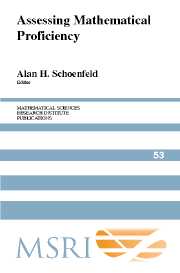Book contents
- Frontmatter
- Contents
- Preface
- Acknowledgments
- Section 1 The Big Picture
- Section 2 Perspectives on Mathematical Proficiency
- Section 3 What Does Assessment Assess? Issues and Examples
- Section 4 The Case of Algebra
- Section 5 What Do Assessments Assess? The Case of Fractions
- 14 Learning About Fractions from Assessment
- 15 Assessing a Student's Mathematical Knowledge by Way of Interview
- 16 Reflections on an Assessment Interview: What a Close Look at Student Understanding Can Reveal
- Section 6 The Importance of Societal Context
- Epilogue: What Do We Need to Know? Items for a Research Agenda
- About the Authors
- Subject Index
- Author Index
- Task Index
14 - Learning About Fractions from Assessment
Published online by Cambridge University Press: 06 July 2010
- Frontmatter
- Contents
- Preface
- Acknowledgments
- Section 1 The Big Picture
- Section 2 Perspectives on Mathematical Proficiency
- Section 3 What Does Assessment Assess? Issues and Examples
- Section 4 The Case of Algebra
- Section 5 What Do Assessments Assess? The Case of Fractions
- 14 Learning About Fractions from Assessment
- 15 Assessing a Student's Mathematical Knowledge by Way of Interview
- 16 Reflections on an Assessment Interview: What a Close Look at Student Understanding Can Reveal
- Section 6 The Importance of Societal Context
- Epilogue: What Do We Need to Know? Items for a Research Agenda
- About the Authors
- Subject Index
- Author Index
- Task Index
Summary
Assessment can be a powerful tool for examining what students understand about mathematics and how they think mathematically. It can reveal students' misconceptions and gaping holes in their learning. It can also reveal the strategies used by successful students. Student responses can raise questions for teachers: Of all the strategies that students are exposed to, which ones do they choose to help make sense of a new situation? Which can they apply accurately? Which aspects of these strategies might be helpful for other students? Assessments can also, with guidance and reflection, provide teachers with a deeper understanding of the mathematical ideas and concepts that underlie the rules and procedures frequently given in textbooks. A good assessment raises questions about changing or improving instruction. The diagnostic and curricular information afforded by assessments can provide powerful tools for guiding and informing instruction.
Over the past seven years, the Mathematics Assessment Collaborative has given formative and summative assessments to students and used their responses in professional development for teachers and to inform instruction. This chapter will share some examples of how assessment can reveal student thinking and raise issues for instructional planning and improvement.
Learning from Formative Assessment
A group of teachers engaged in lesson study was interested in the idea of focusing on students' use of mathematical representations. The teachers had looked at lessons and representations from a variety of sources, including an intriguing lesson from Singapore Primary Mathematics 3B which uses bar models (diagrams which use rectangular “bars” to represent quantities in a problem), triangles, pentagons, hexagons, squares, and circles to represent part-whole relationships.
- Type
- Chapter
- Information
- Assessing Mathematical Proficiency , pp. 195 - 212Publisher: Cambridge University PressPrint publication year: 2007
- 4
- Cited by



